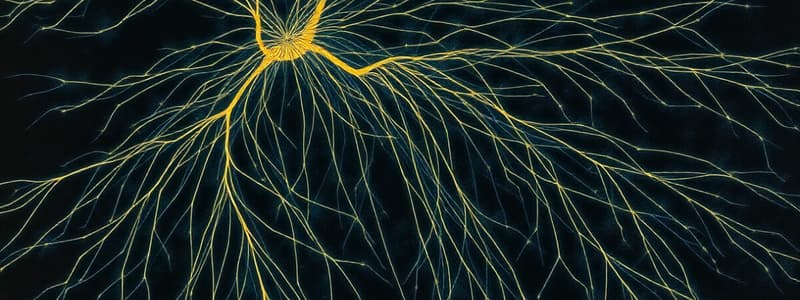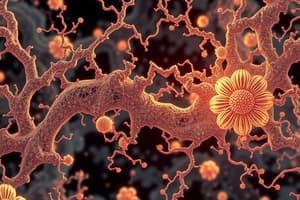Podcast
Questions and Answers
What function does myosin V perform in cells?
What function does myosin V perform in cells?
- Cell division
- Carrying cargo (correct)
- Muscle contraction
- Detoxification
Microtubules grow faster at the minus end than at the plus end.
Microtubules grow faster at the minus end than at the plus end.
False (B)
What is the role of the GTP cap in microtubule dynamics?
What is the role of the GTP cap in microtubule dynamics?
It favors growth.
Myosin V has a long lever arm which allows it to take a bigger step along an actin filament than _____ II.
Myosin V has a long lever arm which allows it to take a bigger step along an actin filament than _____ II.
Match the following components with their descriptions:
Match the following components with their descriptions:
What happens to microtubules when the GTP cap is lost?
What happens to microtubules when the GTP cap is lost?
The -tubulin monomer in microtubules is less tightly bound compared to the other subunit.
The -tubulin monomer in microtubules is less tightly bound compared to the other subunit.
How many protofilaments make up a microtubule?
How many protofilaments make up a microtubule?
What phenomenon describes the ability of microtubules to alternate between growth and rapid disassembly?
What phenomenon describes the ability of microtubules to alternate between growth and rapid disassembly?
A catastrophe refers to the event when a microtubule begins to grow after losing its GTP cap.
A catastrophe refers to the event when a microtubule begins to grow after losing its GTP cap.
Microtubules can undergo a phase of __________ when free tubulin subunits are added, which rescues the microtubule from shrinking.
Microtubules can undergo a phase of __________ when free tubulin subunits are added, which rescues the microtubule from shrinking.
Match the following terms related to microtubules with their descriptions:
Match the following terms related to microtubules with their descriptions:
Which structure is responsible for nucleating microtubules at their minus end?
Which structure is responsible for nucleating microtubules at their minus end?
Individual free tubulin subunits exist in different conformations that affect microtubule stability.
Individual free tubulin subunits exist in different conformations that affect microtubule stability.
What is the significance of the arrangement of microtubules in centrioles?
What is the significance of the arrangement of microtubules in centrioles?
Flashcards
Dynamic instability
Dynamic instability
The process where a microtubule switches between growing and shrinking phases.
GTP cap
GTP cap
A region at the end of a growing microtubule consisting of GTP-bound tubulin subunits.
Catastrophe
Catastrophe
When a microtubule transitions from growth to shrinkage.
Rescue
Rescue
Signup and view all the flashcards
Centrosome
Centrosome
Signup and view all the flashcards
Centriole
Centriole
Signup and view all the flashcards
Pericentriolar material
Pericentriolar material
Signup and view all the flashcards
Microtubule nucleation
Microtubule nucleation
Signup and view all the flashcards
Myosin V
Myosin V
Signup and view all the flashcards
Microtubule Structure
Microtubule Structure
Signup and view all the flashcards
Microtubule Growth Direction
Microtubule Growth Direction
Signup and view all the flashcards
Microtubule Functions
Microtubule Functions
Signup and view all the flashcards
Atomic Force Microscopy
Atomic Force Microscopy
Signup and view all the flashcards
Electron Microscopy
Electron Microscopy
Signup and view all the flashcards
Study Notes
Actin and Myosin in Non-Muscle Cells
- Most non-muscle cells have contractile actin-myosin II assemblies that change cell shape
- These assemblies are regulated by myosin phosphorylation, not troponin
- Contractile actin and myosin in the cell cortex creates tension, leading to changes in cell shape
- Bundles form stress fibers that connect cells to the extracellular matrix or link cells together
- Myosin can be one-headed (myosin I) or two-headed (myosin II).
- Many different types of myosin exist with varying tail structures and functions.
- Myosin V is a type with a long lever arm that allows for large steps on an actin filament.
Microtubules
- Microtubules are more complex than actin filaments but also highly dynamic
- They are made of tubulin heterodimers (α-tubulin and β-tubulin)
- The GTP bound to α-tubulin is fixed, but β-tubulin can be GTP or GDP
- Microtubules have a plus and a minus end. The plus end grows and shrinks faster
- Microtubules show dynamic instability, alternating between growth and shrinkage periods
- Microtubule growth is favored by GTP-tubulin at the plus end, forming a GTP cap.
- Loss of the cap leads to depolymerization
- Dynamic instability involves catastrophe (shrinking) and rescue (growing)
- Nucleation: Microtubules are formed through a complex involving γ-tubulin, which is key component in the complex
- Centrosome: Many animal cells have this microtubule organizing center (MTOC).
- Centrioles: Cylindrical structures embedded in the centrosome.
Centrosome
- Centrosomes function as a microtubule organizing center
- They duplicate before mitosis.
- Centrosomes move apart to form the mitotic spindle poles.
- Centrioles reside within the centrosome, and they are crucial for proper microtubule nucleation.
Studying That Suits You
Use AI to generate personalized quizzes and flashcards to suit your learning preferences.



